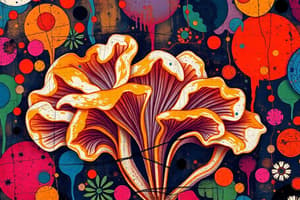Podcast
Questions and Answers
Which component serves as the carbohydrate source for fungi in Czapexsolex media?
Which component serves as the carbohydrate source for fungi in Czapexsolex media?
- Magnesium
- Potassium
- Sodium Nitrate
- Sucrose (correct)
What effect does potassium have on fungal growth?
What effect does potassium have on fungal growth?
- Activates enzymes (correct)
- Reduces carbohydrate metabolism
- Promotes toxic anion formation
- Inhibits enzyme activity
Which nutrient is classified as a micro nutrient necessary for fungal growth?
Which nutrient is classified as a micro nutrient necessary for fungal growth?
- Iron (correct)
- Nitrogen
- Potassium
- Phosphorous
What is the impact of high temperatures on fungal growth based on the observations?
What is the impact of high temperatures on fungal growth based on the observations?
Which component is noted for controlling permeability in fungi?
Which component is noted for controlling permeability in fungi?
What outcome is observed when comparing growth in flasks with and without components?
What outcome is observed when comparing growth in flasks with and without components?
What is the significance of phosphorus in fungal media?
What is the significance of phosphorus in fungal media?
What causes the decrease in growth diameter in flasks missing components?
What causes the decrease in growth diameter in flasks missing components?
Flashcards
Czapexsdox media components
Czapexsdox media components
A mixture of nutrients for fungal growth, including sugar, nitrogen source, phosphorus source, and other essential elements.
Macro nutrients
Macro nutrients
Nutrients needed in larger quantities for fungal growth, such as carbon, nitrogen, and phosphorus.
Micro nutrients
Micro nutrients
Nutrients required in small amounts for fungal growth, like copper, cobalt, and zinc.
Sucrose function
Sucrose function
Signup and view all the flashcards
Fungal growth measurement
Fungal growth measurement
Signup and view all the flashcards
Optimal temperature range for fungal growth
Optimal temperature range for fungal growth
Signup and view all the flashcards
Effect of temperature on fungal growth
Effect of temperature on fungal growth
Signup and view all the flashcards
Potassium's role in fungi
Potassium's role in fungi
Signup and view all the flashcards
Study Notes
Section 2: Essential Nutrient Components for Fungal Growth
-
Czapek Dox Media Components: Sucrose, Sodium Nitrate (NaNO₃), Sulfate (H₂SO₄), and Ferrous Sulfate are nutrient sources for fungal growth.
-
Procedure:
- Prepare several flasks. One flask with all components and others lacking a specific component.
- Sterilize the media in an autoclave at 121°C for 15-20 minutes.
- Pour sterilized media into pre-sterilized plates.
- Allow plates to solidify at room temperature.
- Inoculate plates with tested fungi.
- Incubate plates at 30°C for 7 days.
- Measure fungal growth diameter after incubation.
Observations and Comments
- Nutrient Classification: Nutrients are classified into macro- and micro-nutrients.
- Macro-nutrients: Include Carbon (C), Nitrogen (N), Sulfur (S), Phosphorus (P), and Potassium (K).
- Micro-nutrients: Include Copper (Cu), Cobalt (Co), Calcium (Ca), Zinc (Zn), and Iron (Fe).
- Element Importance: Each element plays a crucial role, for example, sucrose is a carbon source that is necessary for carbohydrates synthesis.
- Fungal Growth Affected by Temperature & Other Components: The first flask that has all the components will show higher growth compared to others, and the growth diameter decreases when comparing the first plate to others.
- Lower temperatures can decrease fungal growth as enzymes' activity reduces due to decreased kinetic energy.
- Higher temperatures that break down the enzymes, resulting in reduced nutrient absorption and growth.
Potassium (K⁺)
- Enzyme Activator: Potassium is a crucial activator for enzymes, without it, enzymes cannot function properly.
- Toxic Ion Removal: Potassium's role is also to clear negative charges or toxic ions from fungi.
- Permeability Regulator: It appears to be associated with controlling the permeability of the fungal cell wall.
Effect of Temperature on Fungal Growth
-
Procedure: Prepare Czapek Dox media. Autoclave at 121°C for 15-20 min. Pour media into pre-sterilized Petri dishes. Allow to solidify at room temp. Inoculate with fungi. Incubate at various temperatures (5°C , 15°C, 30°C, 45°C) for 7 days. Measure diameter.
-
Observation: Growth rate is highest at a specific temperature and decreases above and below this optimum temperature range. Optimum temperature for each fungus type varies.
-
Minimum Temperature: The lowest temperature at which growth begins to occur.
Studying That Suits You
Use AI to generate personalized quizzes and flashcards to suit your learning preferences.




